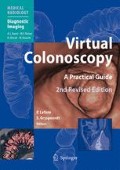A climatic new era of data validation has been reached for CTC screening in both asymptomatic cohorts and patients at increased risk (Johnson et al. 2008; Graser et al. 2009; Regge 2009; Kim et al. 2007; Pickhardt et al. 2003). In 2008 the American Cancer Society released a joint guideline with the US Multisociety colorectal task force and the American College of Radiology recommending CTC, along with other proven modalities, for colorectal screening (Levin et al. 2008). Thus, the pathway to broader community implementation of CTC for screening has began to evolve in the United States and worldwide (Thomas et al. 2008). Concordant with the continued technological evolution and increased translation into screening cohorts, there is a need to reinforce how to most effectively interpret the data.
Important differences in acquisition methods have varied in stool tagging and low-dose techniques, while image display techniques have ranged from primary detection with 2D multiplanar reformation (2D MPR) to 3D endoscopic fly-through techniques. Although differences exist, there are key issues of image display techniques which are important to understand for data interpretation.
Access this chapter
Tax calculation will be finalised at checkout
Purchases are for personal use only
References
Johnson CD, Chen MH, Toledano AY et al (2008) Accuracy of CT colonography for detection of large adenomas and cancers. NEJM 359:1207–1217
Graser A, Stieber P, Nagel D et al (2009) Comparison of CT colonography, colonoscopy, sigmoidoscopy and fecal occult blood tests for the detection of advanced adenoma in an average risk population. Gut 58:241–248
Regge D, Laudi C, Galatola G, et al (2009) Accuracy of CT colonog-raphy in subjects at increased risk of colorectal carcinoma: a multi-center trial of 1,000 patients. JAMA 301:2453–2461.
Kim DH, Pickhardt PJ, Taylor AJ et al (2007) CT colonography versus colonoscopy for the detection of advanced neopla-sia. N Engl J Med 357:1403–1412
Pickhardt PJ, Choi JR, Hwang I, Butler JA, Puckett ML, Hildebrandt HA et al (2003) Computed tomographic virtual colonoscopy to screen for colorectal neoplasia in asymptomatic adults. N Eng J Med 349:2191–2200
Levin B, Lieberman DA, McFarland B, Smith RA, Brooks D, Andrews KS et al (2008) Screening and Surveillance for the early detection of colorectal cancer and adenomatous polyps 2008: a joint guideline from the American Cancer Society, the US Multi-society task force on colorectal cancer, and the American College of Radiology. CA Cancer J Clin 58:130–160
Thomas J, Carenza J, McFarland E (2008) Computed tomo-graphic colonography (virtual colonoscopy): climax of a new era of validation and transition into community practice. Clin Colon Rectal Surg 21:220–232
Laks S, Macari M, Bini EJ (2004) Positional change in colon polyps at CT colonography. Radiology 231:761–766
Pickhardt PJ, Lee AD, McFarland EG, Taylor AJ (2005) Linear polyp measurement at CT colonography: in vitro and in vivo comparison of two-dimensional and three-dimensional displays. Radiology 236:872–878
O'Connor SD, Summer RM, Choi JR, Pickhardt PJ (2006) Oral contrast adherence to polyps on CT colonography. J Comput Assit Tomogr 30:51–57
Fidler JL, Johnson CD, MacCarty RL, Welch TJ, Hara AK, Harmsen WS (2002) Detection of flat lesions in the colon with CT colonography. Abdom Imaging 27:292–300
Pickhardt PJ, Nugent PA, Choi JR, Schindler WR (2004) Flat colorectal lesions in asymptmatic adults: implications for screening with CT virtual colonoscopy. AJR 183:1343–1347
Soetikno RM, Kaltenbach T, Rouse RV, Park W, Maheshwari A, Sato T et al (2008) Prevalence of nonpolypoid (flat and depressed) colorectal neoplasia in asymptomatic and symptomatic adults. JAMA 299:1027–1035
Zalis ME, Barish MA, Choi JR, Dachman AH, Fenlon HM, Ferrucci JT, Glick SN, Laghi A, Macari M, McFarland EG, Morrin MM, Pickhardt PJ, Soto J, Yee J (2005) CT colonog-raphy reporting and data system: a consensus proposal. Radiology 236:3–9
Van Dam J, Cotton P, Johnson CD, McFarland BG, Pineau BC, Provenzale D, Ransohoff D, Rex D, Rockey D, Wootton T (2004) AGA future trends report: CT colonography. Gastro-enterology 127:970–984
Lieberman D (2006) A call to action—measuring the quality of colonoscopy. N Engl J Med 355:2588–2589
Author information
Authors and Affiliations
Editor information
Editors and Affiliations
Rights and permissions
Copyright information
© 2010 Springer-Verlag Berlin Heidelberg
About this chapter
Cite this chapter
McFarland, B.G. (2010). How to Interpret CTC Data: Evaluation of the Different Lesion Morphologies. In: Lefere, P., Gryspeerdt, S. (eds) Virtual Colonoscopy. Medical Radiology. Springer, Berlin, Heidelberg. https://doi.org/10.1007/978-3-540-79886-6_9
Download citation
DOI: https://doi.org/10.1007/978-3-540-79886-6_9
Publisher Name: Springer, Berlin, Heidelberg
Print ISBN: 978-3-540-79879-8
Online ISBN: 978-3-540-79886-6
eBook Packages: MedicineMedicine (R0)

